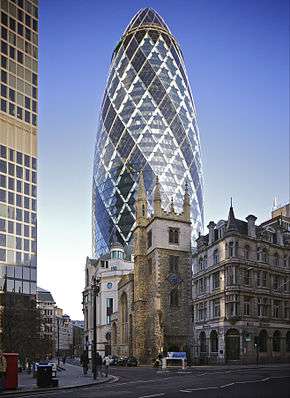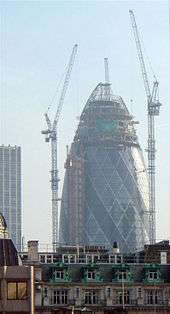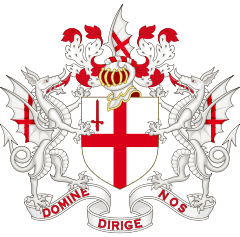30 St Mary Axe
| 30 St Mary Axe | |
|---|---|
 30 St Mary Axe, with St Andrew Undershaft church in the foreground, pictured from Leadenhall Street | |
| General information | |
| Status | Complete |
| Type | Office |
| Architectural style | Neo-futuristic |
| Location |
St Mary Axe, London, EC3 United Kingdom[1][2] |
| Coordinates | 51°30′52″N 00°04′49″W / 51.51444°N 0.08028°WCoordinates: 51°30′52″N 00°04′49″W / 51.51444°N 0.08028°W |
| Construction started | 2001 |
| Completed | 2003[3] |
| Opening | 28 April 2004[4][5] |
| Cost |
£138 million (plus land cost of £90.6 million)[6] adjusted for inflation: £206 million (plus land cost of £144 million)[6][7] |
| Height | |
| Roof | 180 metres (591 ft) |
| Technical details | |
| Floor count | 41 |
| Floor area | 47,950 square metres (516,100 sq ft) |
| Design and construction | |
| Architect | Foster and Partners |
| Structural engineer | Arup |
| Main contractor | Skanska |
| References | |
| [8] | |
30 St Mary Axe (informally known as The Gherkin and previously as the Swiss Re Building) is a commercial skyscraper in London's primary financial district, the City of London. It was completed in December 2003 and opened in April 2004.[4] With 41 storeys, it is 180 metres (591 ft) tall[3] and stands on the former sites of the Baltic Exchange and Chamber of Shipping, which were extensively damaged in 1992 by the explosion of a bomb placed by the Provisional IRA in St Mary Axe, the street from which the tower takes its name.[4][9]
After plans to build the 92-storey Millennium Tower were dropped, 30 St Mary Axe was designed by Norman Foster and Arup Group[10] and it was erected by Skanska, with construction commencing in 2001.[3]
The building has become a recognisable feature of London and is one of the city's most widely recognised examples of contemporary architecture.
History
Site
The building stands on the former sites of the Baltic Exchange (24-28 St Mary Axe), the headquarters of a global marketplace for ship sales and shipping information, and the Chamber of Shipping (30-32 St Mary Axe). On 10 April 1992 the Provisional IRA detonated a bomb close to the Exchange, causing extensive damage to the historic building and neighbouring structures.[4][9]
The United Kingdom government's statutory adviser on the historic environment, English Heritage, and the City of London's governing body, the City of London Corporation, were keen that any redevelopment must restore the Baltic Exchange's old façade onto St Mary Axe. The Exchange Hall was a celebrated fixture of the ship trading market.[11][12]
After English Heritage later discovered the damage was far more severe than initially thought, they stopped insisting on full restoration, albeit over the objections of the architectural conservationists who favoured reconstruction.[13] The Baltic Exchange and the Chamber of Shipping sold the land to Trafalgar House in 1995.[14] Most of the remaining structures on Baltic Exchange site were then carefully dismantled, the interior of Exchange Hall and the façade were preserved, hoping for a reconstruction of the building in the future.[14] The salvaged material was eventually sold for £800,000 and moved to Tallinn, Estonia, where it awaits reconstruction as the centrepiece of the city's commercial sector.
In 1996, Trafalgar House submitted plans for the Millennium Tower, a 386-metre (1,266 ft) building with more than 140,000 m2 (1,500,000 sq ft) of office space, apartments, shops, restaurants and gardens. This plan was dropped after objections for being totally out-of-scale with the City of London and anticipated disruption to flight paths for both London City and London Heathrow airports; the revised plan for a lower tower was accepted.
The tower's topmost panoramic dome, known as the "lens", recalls the iconic glass dome that covered part of the ground floor of the Baltic Exchange and much of which is now displayed at the National Maritime Museum.[4][15]
The Gherkin nickname was applied to the current building at least as long ago as 1999, referring to that plan's highly unorthodox layout and appearance.[16]
Planning process
On 23 August 2000, Deputy Prime Minister John Prescott granted planning permission to construct a building much larger than the old Exchange on the site.[11] The site was special because it needed development, was not on any of the "sight lines" (planning guidance requires that new buildings do not obstruct or detract from the view of St Paul's dome when viewed from a number of locations around London), and it had housed the Baltic Exchange.
The plan for the site was to reconstruct the Baltic Exchange. GMW Architects proposed a new rectangular building surrounding a restored exchange—the square shape would have the type of large floor plan that banks liked. Eventually, the planners realised that the exchange was not recoverable, forcing them to relax their building constraints; they hinted that an "architecturally significant" building might obtain a favourable reception from city authorities. This gave the architect a free hand in the design; it eliminated the restrictive demands for a large, capital-efficient, money-making building, whose design was per the client's desire.[17]
Swiss Re's low level plan met the planning authority's desire to maintain London's traditional streetscape with its relatively narrow streets. The mass of the Swiss Re tower was not too imposing. Like Barclays Bank's former City headquarters in Lombard Street, the idea was that the passer-by in neighbouring streets would be nearly oblivious to the tower's existence until directly underneath it.
Design and construction
The building was constructed by Skanska, completed in December 2003 and opened on 28 April 2004.[4] The primary occupant of the building is Swiss Re, a global reinsurance company, which had the building commissioned as the head office for its UK operation. The tower is thus sometimes known as the Swiss Re Building, although this name has never been official and has more recently fallen out of favour, since the company's main headquarters is in Zurich and the Gherkin name has become more popular.[18]

The building uses energy-saving methods, which allow it to use half the power that a similar tower would typically consume.[18] Gaps in each floor create six shafts that serve as a natural ventilation system for the entire building, even though required firebreaks on every sixth floor interrupt the "chimney". The shafts create a giant double glazing effect; air is sandwiched between two layers of glazing and insulates the office space inside.[4]
Architects promote double glazing in residential houses, which avoids the inefficient convection of heat across the relatively narrow gap between the panes, but the tower exploits this effect. The shafts pull warm air out of the building during the summer and warm the building in the winter using passive solar heating. The shafts also allow sunlight to pass through the building, making the work environment more pleasing, and keeping the lighting costs down.
The primary methods for controlling wind-excited sways are to increase the stiffness, or increase damping with tuned/active mass dampers. To a design by Arup, its fully triangulated perimeter structure makes the building sufficiently stiff without any extra reinforcements. Despite its overall curved glass shape, there is only one piece of curved glass on the building — the lens-shaped cap at the apex.[4]
On the building's top level (the 40th floor), there is a bar for tenants and their guests, featuring a panoramic view of London. A restaurant operates on the 39th floor, and private dining rooms on the 38th.[18] Whereas most buildings have extensive lift equipment on the roof of the building, this was not possible for the Gherkin, since a bar had been planned for the 40th floor. The architects dealt with this by having the main lift only reach the 34th floor, and then having a push-from-below lift to the 39th floor. There is a marble stairwell and a disabled persons' lift which leads the visitor up to the bar in the dome.
The building is visible over long distances: From the north, for instance, it can be seen from the M11 motorway, some 32 kilometres (20 mi) away,[18][19] while to the west it can be seen from the statue of George III in Windsor Great Park.
After completion
In April 2005, the press reported that a glass panel two-thirds up the tower had fallen to the plaza beneath. The plaza was sealed off, but the building remained open. A temporary covered walkway, extending across the plaza to the building's reception, was erected to protect visitors. Engineers examined the other 744 glass panels on the building.[20] The cost of repair was covered by main contractor Skanska and curtain-wall supplier Schmidlin (now called Schmidlin-TSK AG).[18]
Since its completion, the building has won a number of awards for architecture. In October 2004, the architect was awarded the 2004 RIBA Stirling Prize. For the first time in the prize's history, the judges reached a unanimous decision.[21] In December 2005, a survey of the world's largest firms of architects published in 2006 BD World Architecture 200 voted the tower as the most admired new building in the world. However, Ken Shuttleworth, who worked for Foster and Partners on the design of the building, said in 2011 that he believed the style was now out-moded: "I was looking at the glass all around and [thought], 'Why on earth did we do that?' Now we would do things differently".[22] The building featured in recent films such as Harry Potter and the Half Blood Prince, Russell Crowe's A Good Year, Sharon Stone's Basic Instinct 2, and Woody Allen's Match Point[23] and, rechristened the Spirit of London, became the spaceship centrepiece of Keith Mansfield's 2008 novel Johnny Mackintosh and the Spirit of London.[24]
In September 2006, the building was put up for sale with a price tag of £600 million.[25] Potential buyers included British Land, Land Securities, Prudential, ING, and the Abu Dhabi royal family. On 21 February 2007, IVG Immobilien AG and UK investment firm Evans Randall completed their joint purchase of the building for £630 million, making it Britain's most expensive office building.[26][27] Swiss Re booked a gain of more than £300 million from the sale.[28] The new owners are seeking compensation from four of their former managers on the deal, in which about £620 million was paid for a building with a build cost of about £200 million, giving the previous owners a clear £300 million profit.[29]
Since February 2010,[30] Sky News has broadcast its flagship business programme, Jeff Randall Live, from a studio in the building. In addition the top two floors of tower are now available on a private hire basis for events.[31]
Deloitte announced in April 2014 that the building was again being put up for sale, with an expected price of £550 million.[32] The current owners could not afford to make loan repayments, citing differences in the value of the multi-currency loan and the British pound, high interest rates and general financing structure.[33] In November 2014, the Gherkin was purchased for £700 million by the Safra Group, controlled by the Brazilian billionaire Joseph Safra.[34]
Tenants
As of January 2015, current occupiers of the building include:
- Standard Life
- SuperDerivatives - now owned by Intercontinental Exchange
- Allied World Assurance
- Regus
- ION Trading
- Kirkland & Ellis
- Deutsche Pfandbrief bank AG
- Hunton & Williams
- Coleman Bennett International Consultancy Plc
- Falcon Group
- IPsoft
- Live Free
- Swiss Re
- Lab49
- RightShip
Additionally, retailers and restaurants operate from the site, including The Sterling and Bridge's Newsagent.
See also
- Landmarks of London
- Diagrid
- List of tallest buildings and structures in London
- Mathematics and architecture
- Mode Gakuen Cocoon Tower, a similar-shaped building in Tokyo
- Torre Agbar, a similar-shaped building in Barcelona
- Willis Building, another Norman Foster building
References
- ↑ "Gherkin London".
- ↑ "The Gherkin".
- 1 2 3 "30 St Mary Axe, London". Skanska. Archived from the original on 4 February 2010. Retrieved 4 February 2010.
- 1 2 3 4 5 6 7 8 "30 St Mary Axe". Emporis. Retrieved 4 February 2010.
- ↑ Worsley, Giles (28 April 2004). "Glory of the Gherkin". The Daily Telegraph. London.
- 1 2 "30 St Marys Axe, London - Building #58". Skyscrapernews.com. Retrieved 3 June 2014.
- ↑ UK CPI inflation numbers based on data available from Gregory Clark (2016), "The Annual RPI and Average Earnings for Britain, 1209 to Present (New Series)" MeasuringWorth.
- ↑ 30 St Mary Axe at Emporis
- 1 2 "1993: IRA bomb devastates City of London". BBC News. 24 April 1993. Archived from the original on 2 February 2010. Retrieved 2 February 2010.
- ↑ "30 St Mary Axe (The Gherkin)". Arup. Archived from the original on 18 February 2010. Retrieved 4 February 2010.
- 1 2 "'Erotic gherkin' for London skyline". BBC News. 23 August 2000. Archived from the original on 7 February 2010. Retrieved 7 February 2010.
- ↑ Lane, Megan (5 July 2007). "Extreme restoration". BBC News. Archived from the original on 7 February 2010. Retrieved 6 February 2010.
- ↑ Murray-West, Rosie (30 September 2000). "Baltic backs legal fight over 'gherkin'". London: Telegraph. Retrieved 6 February 2010.
- 1 2 "History – 1949-Today". Baltic Exchange. Archived from the original on 4 February 2010. Retrieved 4 February 2010.
- ↑ "Baltic Exchange Memorial Glass". www.rmg.co.uk. National Maritime Museum. Retrieved 2 December 2014.
- ↑ "No gherkins please, we're British". London: The Guardian. 6 August 1999. Retrieved 28 November 2009.
- ↑ "Issues – The newsletter of GMW Architects" (PDF). GMW Architects. p. 3. Archived from the original (PDF) on 16 October 2007. Retrieved 6 February 2010.
- 1 2 3 4 5 Spring, Martin (2008). "30 St Mary Axe: A gherkin to suit all tastes". Building.co.uk. Retrieved 7 February 2010.
- ↑ Hossenally, Rooksana. "The Gherkin, London, UK". EasyVoyage.co.uk. Retrieved 6 February 2010.
- ↑ Bar-hillel, Mira; Harris, Ed (2005). "Safety fear over Gherkin". London Evening Standard. Retrieved 4 February 2010.
- ↑ "Building prize for 'icon Gherkin'". BBC News. 16 October 2004.
- ↑ Eden, Richard (26 June 2011). "Architect behind the Gherkin says he has finished designing strangely shaped edifices". The Daily Telegraph. London.
- ↑ Sandhu, Sukhdev (21 June 2006). "Sex on the skyline". The Daily Telegraph. London. Retrieved 6 February 2010.
- ↑ "Keith Mansfield 2009 on Johnny Mackintosh and the spirit of London". BFKbooks. 2009. Retrieved 19 February 2010.
- ↑ Davey, Jenny (16 September 2006). "Prize Gherkin put up for sale". The Times. London. Archived from the original on 4 February 2010. Retrieved 4 February 2010.
- ↑ Walsh, Fiona (6 February 2007). "Gherkin sold for £600m". The Guardian. London. Archived from the original on 4 February 2010. Retrieved 4 February 2010.
- ↑ Inman, Phillip (6 February 2007). "Gherkin's £600m sale sets London property record". The Guardian. London. Archived from the original on 4 February 2010. Retrieved 4 February 2010.
- ↑ "Why Swiss RE Would Sell The Gherkin... - Article #720". Skyscrapernews.com. 19 September 2006. Retrieved 3 June 2014.
- ↑ "IVG seeks compensation from former managers over Gherkin deal". Property Mall. 10 December 2013.
- ↑ Phipps, Nick (23 February 2010). "Sky's City Studio: 'Don't Mention The G-Word'". London: Sky News. Archived from the original on 1 February 2012. Retrieved 29 November 2010.
- ↑ "United Kingdom: The Gherkin : Events Hire". hirespace.com. Retrieved 17 January 2014.
- ↑ Macalister, Terry; Kollewe, Julia (24 April 2014). "Gherkin's salad days over amid financial pickle for London tower". The Guardian. London.
- ↑ "Deloitte appointed Receivers to 30 St Mary Axe" (Press release). Deloitte. 24 April 2014.
- ↑ "Gherkin bought by Brazilian banking giant for £700m" (Press release). The Daily Telegraph. 10 November 2014.
External links
| Wikimedia Commons has media related to 30 St Mary Axe. |
